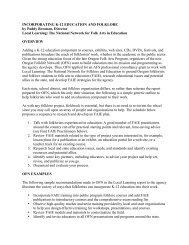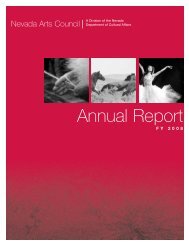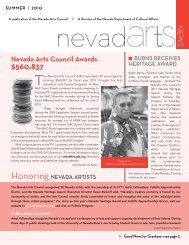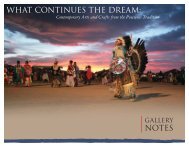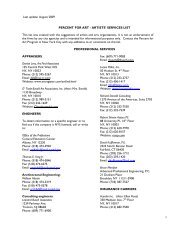Handed Down - Nevada Arts Council
Handed Down - Nevada Arts Council
Handed Down - Nevada Arts Council
Create successful ePaper yourself
Turn your PDF publications into a flip-book with our unique Google optimized e-Paper software.
1997–1998<br />
Paiute Buckskin Tanning:<br />
Wesley Dick and Donald Hicks<br />
In an unusual apprenticeship where the master was<br />
half the age of the apprentice, Wesley Dick taught<br />
Donald “Ike” Hicks the art of traditional Paiute and<br />
Shoshone hide tanning. Both men live in Fallon, where<br />
Wesley was raised and where Ike has now retired. Ike’s<br />
father was Shoshone from central <strong>Nevada</strong>, and his<br />
mother was Paiute from Schurz. He grew up ranching,<br />
worked in Carson City for many years, and is now at his<br />
mother’s old place keeping a few cows and horses and<br />
raising some hay. Wesley has been tanning hides for 15<br />
years, and hasn’t found many young people interested<br />
in learning the time-consuming and messy process, but<br />
Ike has the time and interest. The two have hunted<br />
together in the past, although for this apprenticeship<br />
they had to buy deer hides from a friend in Owyhee.<br />
On a warm April day at Ike’s place east of Fallon<br />
on the Stillwater reservation, he has deer hides in several<br />
stages of preparation. A large metal tank holds<br />
some fresh hides soaking in water, where they will stay<br />
for four to six days until the hair comes off easily. Ike<br />
hangs a wet hide over a smooth horizontal log beam<br />
and scrapes the flesh and hair off with a drawknife, a<br />
long slightly-curved blade with handles at both ends so<br />
it can be pulled toward the user. The next step in the<br />
process is to rub brains into the hide, which is the actual<br />
tanning process and leaves the skin soft and white.<br />
Traditionally deer brains were used, but nowadays Ike<br />
has to get beef brains from the local butcher shop. As he<br />
spreads the wet hide on a table and begins working the<br />
brains into it, he says, “I should be singing.” There are<br />
traditional songs used in the tanning process, acknowledging<br />
the gift of the animal for human use, but Ike<br />
never learned them from his elders after he went away<br />
to boarding school.<br />
After the hide is covered with the brains it is hung<br />
up to dray, and then soaked again in water to get the<br />
smell out. The brains are rinsed out, and then the real<br />
work begins – pulling the hide over the end of a smooth<br />
log set in the ground, to dry and soften it. Ike reports<br />
that Wesley told him it takes a thousand pulls to get a<br />
hide done. This is laborious work, hard on the hands<br />
and the back, but it results in an exceptionally soft and<br />
white hide that can be used for dresses, cradleboard<br />
covers, moccasins, gloves and other traditional elements<br />
of Paiute and Shoshone costumes. Hides are often<br />
smoked over wood chips to give them a golden color,<br />
but are usually left white if they are made into dresses.<br />
Ike also uses raw hides, those that are not tanned, to<br />
make drums.<br />
Ike Hicks scrapes the hair off a deer hide in preparation for tanning.<br />
Ike Hicks<br />
54




